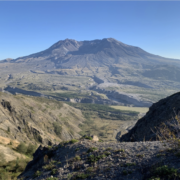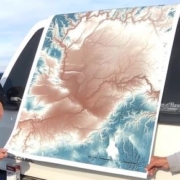Richard W. Galster recently passed away. Click on the following link to learn more about his contributions: Richard W. Galster
Retired U.S. Geological Survey geologist James Minard passed away peacefully with his family at his side on June 16, 2011, at Providence General Hospital in Everett, WA. He was 90 years old. He was preceded in death by his wife Velma Anne and daughter Marelea Cameron, and he is survived by his sister Jean Umberger, his elder daughter Sonja Reinheimer, sons Jamie and Brent Minard, and seven grandchildren. His obituary will appear in the July 3 issue of the Everett Herald, where interested parties can digitally sign the guest book. Memorial services will be held at Weller Funeral Home in Arlington, WA, at 1:00 P.M. on Thursday, July 7.
Summary of his life and work
James (“Jim”) Pierson Minard was born on March 22, 1921 in Morristown, NJ, the youngest of three sons of Robert and Eleanor Minard. He grew up on a dairy farm in Chester, NJ. After graduating from Morristown High School in 1940, he worked as a machinist mate at Piccatiny Arsenal in Dover, NJ. In April, 1942, four months after the attack on Pearl Harbor, he and his lifelong friend Frank Markewicz joined the Navy, and they served out the war together, mainly in the South Pacific. While stationed in Bremerton, WA, Jim met Velma Cross. Jim and Velma were married in San Diego, CA, in May, 1944. Jim left the Navy in October, 1945, and for the next couple of years he worked in the Seattle area as a gas station manager, during which time daughters Sonja and Marelea were born. Intent on pursuing his education, Jim moved his family back to New Jersey in 1947, and for the next twelve years he attended college while simultaneously working to support his family. Early in this period, during the summers of 1949 and 1950, he was employed as a geologic field assistant with the USGS on the north slope of the Brooks Range, Alaska; his brother Bud accompanied him to Alaska on both occasions, working for the USGS as a field camp cook. In 1951 Jim worked for the US Navy Hydrographic Office in Washington D.C., and in the same year he joined the Naval Reserves, from which he ultimately retired in 1967 as a Lieutenant Commander. He earned a B.A. in Geology at Upsala College in 1951, and a M.S. in Geology at Rutgers (New Brunswick campus) in 1959. While a student at Rutgers, his sons Jamie (1952) and Brent (1958) were born.
Jim obtained a permanent position with the USGS in 1951. For much of his career he was stationed at sites around the greater Washington, D.C. area, including Building 10 at the National Bureau of Standards, then at offices in Crystal City, and finally at the National Center in Reston, VA, when it was completed in 1974. His main assignments during this period involved the Colorado Plateau (1955-1956), Atlantic Coastal Plain (1957-1977), and Eastern Triassic basins (1966-1970), and he also worked briefly in Wyoming (1956), Egypt (1961), and Kentucky (1962). His chief accomplishments included correlating Coastal Plain stratigraphy from New Jersey through Maryland, which he described in a series of Professional Papers and GQ maps. Another key contribution was his landmark study of coastal slump blocks and associated slope-related hazards affecting heavily developed areas in the Navesink Highlands of New Jersey, which Jim presented in a 1974 Professional Paper. In addition to describing the distribution, morphology, and mechanics of the slump blocks, he showed how poorly-designed drainage modifications, road building, and other construction activities triggered slumping by destabilizing the slopes. The conclusions and recommendations in his report form the basis for present policies controlling slope development in the region.
Jim’s work and his personal life took a major turn in 1977, when he moved his family to the Pacific Northwest and he began working out of the Seattle office of the USGS. Jim and Velma established a home in nearby Everett—just across Puget Sound from the Bremerton naval base where they first met—and he immersed himself in the geology of the Puget Lowlands and Cascade foothills of western Washington. These studies, conducted over a 5-year span, turned out to be one of his favorite duties for the USGS. It was also one of his most prolific periods, yielding fifteen MF quadrangle maps addressing the Quaternary geology of a broad, rapidly urbanizing region between Seattle and Marysville. Jim’s transplantation across the country provided an opportunity to compare and contrast surficial geologic processes on opposite coasts of the U.S. and to share his new insights with former colleagues on the east coast, with whom he remained in fruitful contact. The fifteen maps reflect a prodigious amount of detailed geologic field study and stratigraphic interpretation that form the capstone of Jim’s career. Like his previous works, these are well-crafted, scientifically robust products, and they are still routinely consulted as key data sources by the research geologists and geotechnical specialists currently working in the region.
Jim retired from the USGS in 1982 in order to spend more time with his adored wife, Velma. Sadly, she died only a year later. He carried into retirement his lifelong passion for outdoor activities including hiking, mountain climbing, and fishing, while running a geologic consulting business and advising geotechnical and geohydrology companies and regional governmental agencies in western Washington State about the geologic hazards and subsurface conditions revealed by his extensive geologic mapping. With the assistance of his son Brent, Jim kept at his consulting work until around 2005, when he was 85.
From the following accounts of his colleagues, friends, and acquaintances, it appears likely that Jim Minard will long be remembered for his warmth, honesty, wry sense of humor, enthusiasm for hard work, and for his impartial accessibility and generosity toward everyone—colleagues and “greenhorns” alike—as well as for his considerable scientific accomplishments.
Personal remembrances
Lucy McCartan Manheim, Fairfax, VA
Jim was a close friend; I will miss his warm smile and great sense of humor.



